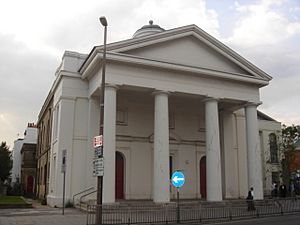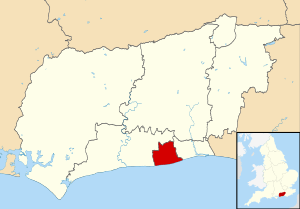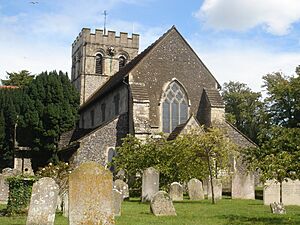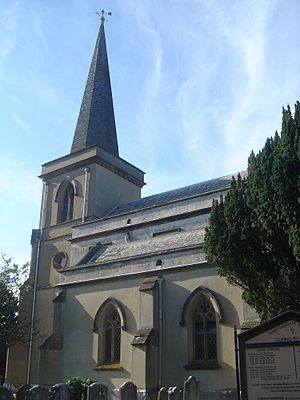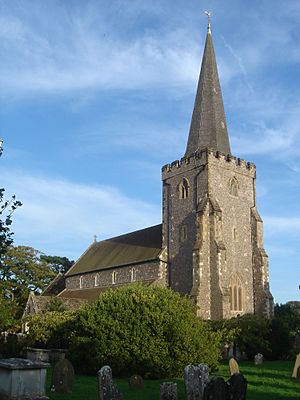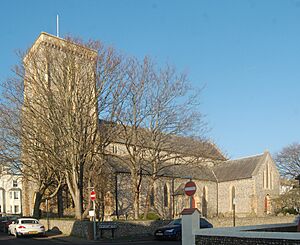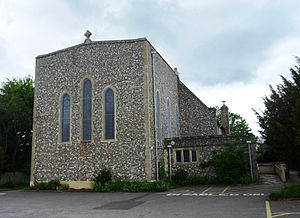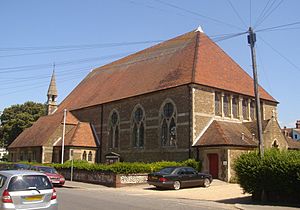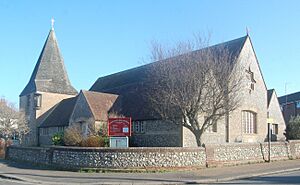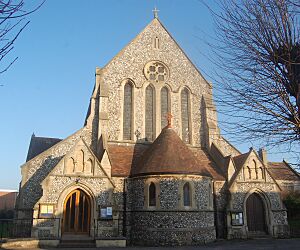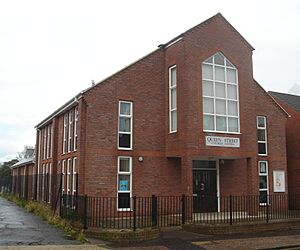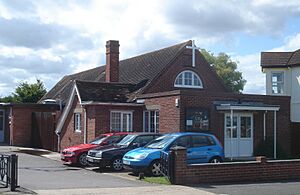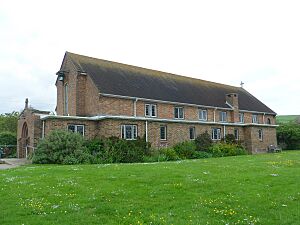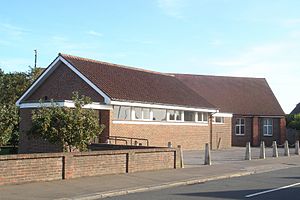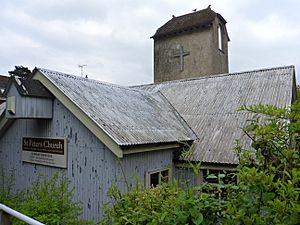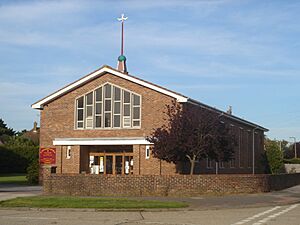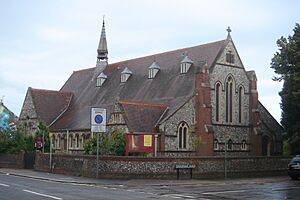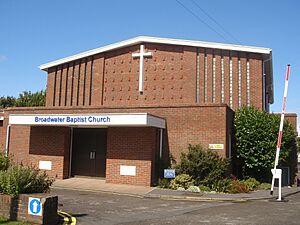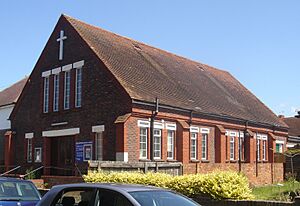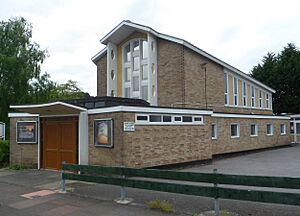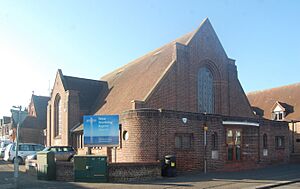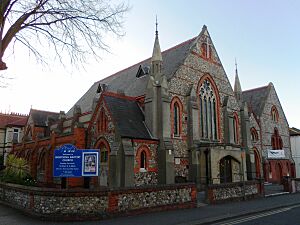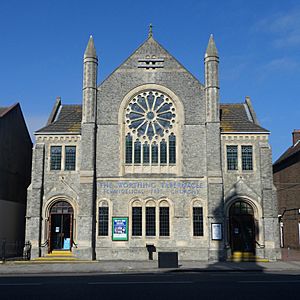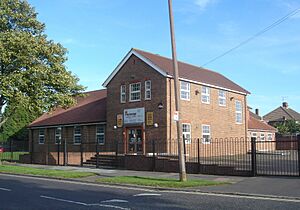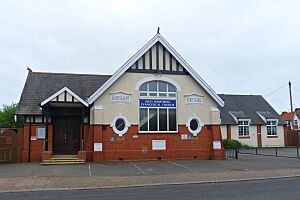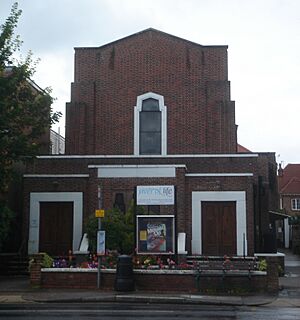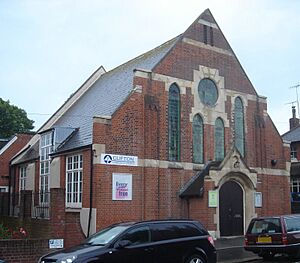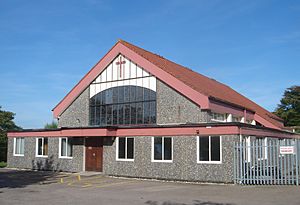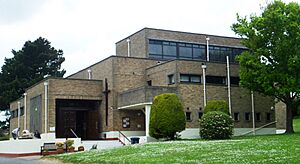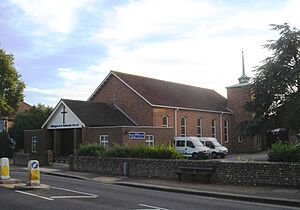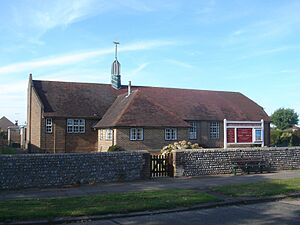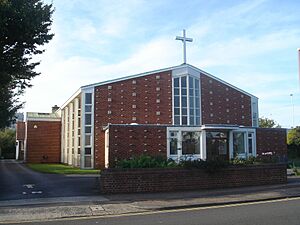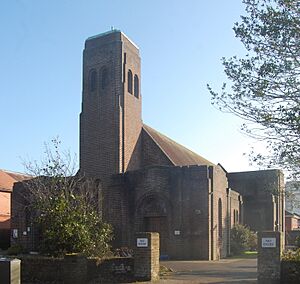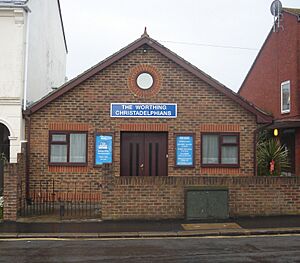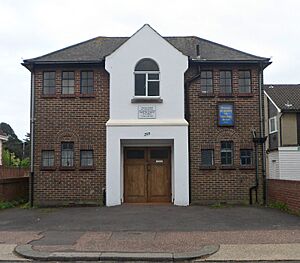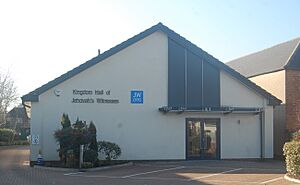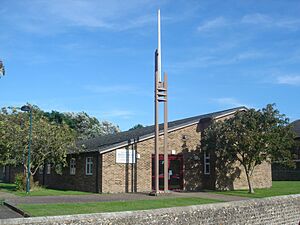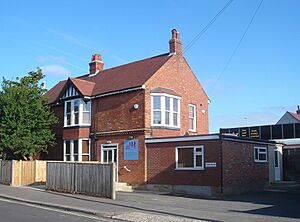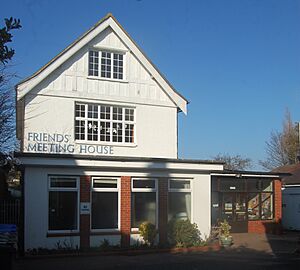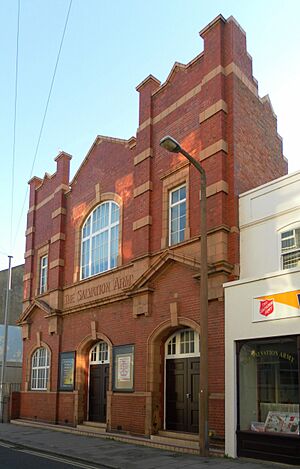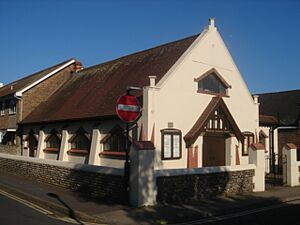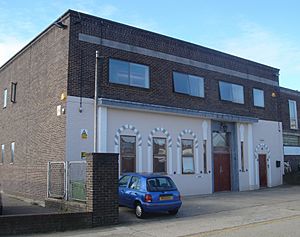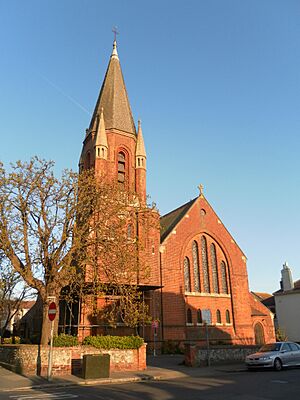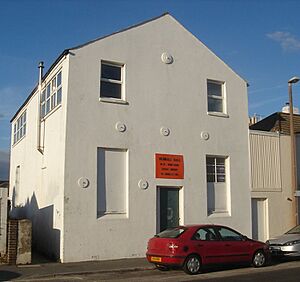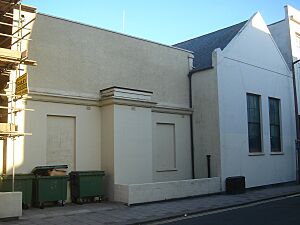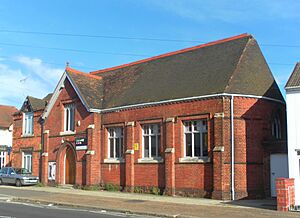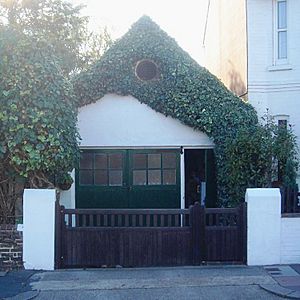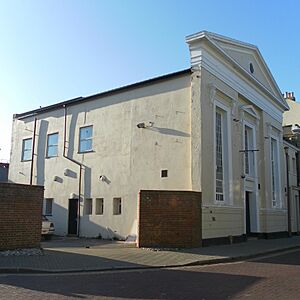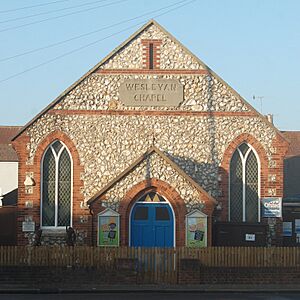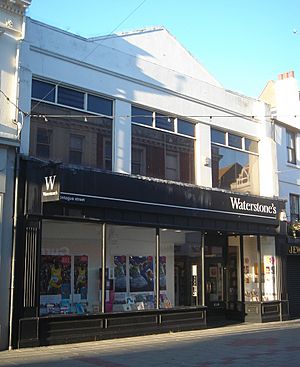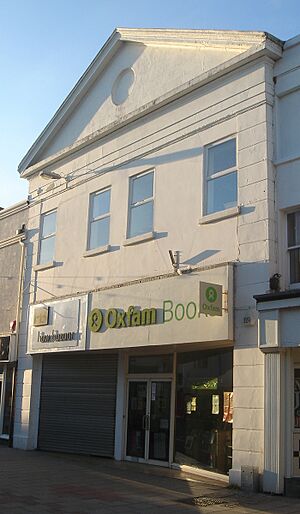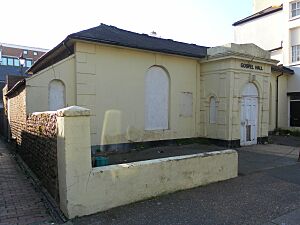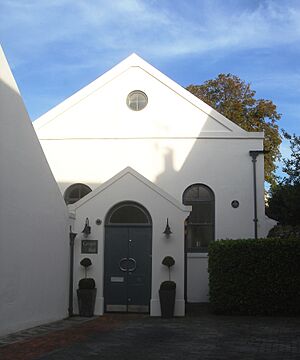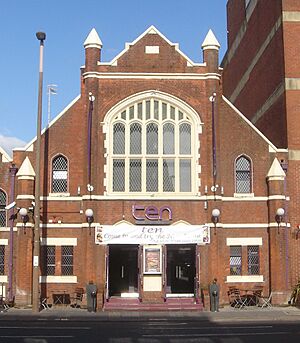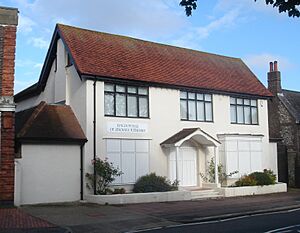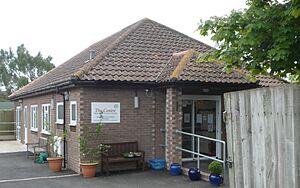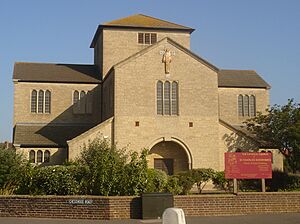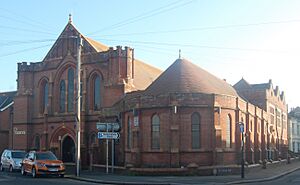List of places of worship in Worthing facts for kids
Worthing, a town on the south coast of England, is home to many churches and other places of worship. There are 43 active religious buildings and 21 former ones that are still standing but used for other purposes. Worthing is mostly a town with many homes, from old villages that became part of the town to newer housing areas built after World War II.
Most people in Worthing are Christians. There is also one non-Christian place of worship, which is a mosque. The Church of England, the official church of the country, has more churches in Worthing than any other Christian group. However, the very first church in Worthing was an Independent chapel. Other Protestant groups, called Nonconformists, grew popular in the early 1800s as the town developed. Roman Catholic worship became established a bit later.
Twelve of Worthing's active churches and two former church buildings have been given "listed status" by English Heritage. This means they are special because of their history or architecture. Buildings are listed to protect them. There are three levels of listed status:
- Grade I: For buildings of "exceptional interest"—the most important ones.
- Grade II*: For "particularly important buildings" that are more than just special.
- Grade II: For buildings of "special interest."
Contents
Worthing's Religious History
Worthing covers about 8,030 acres (3,250 hectares) along the English Channel coast in West Sussex. It is bordered by other districts and the sea.
The town of Worthing started as a small fishing village. It grew quickly into a popular place to live, partly because of the growth of nearby Brighton. Worthing eventually included older villages like Broadwater, Goring, Heene, and West Tarring. It officially became a borough in 1890.
The older villages had their own Anglican churches. Worthing itself used St Mary's Church in Broadwater until St Paul's Church was built in 1812. St Paul's quickly became a very important place for the town's spiritual and social life, even though it had money problems and was criticized for not helping the poor enough. Other Anglican churches were built in the town centre later in the 1800s. For example, Christ Church also started as a smaller chapel connected to St Mary's before it got its own parish. Today, some churches face challenges due to fewer people attending services.
The very first place of worship in Worthing was an Independent chapel built in 1804 on what is now Montague Street. This building is no longer there. Nonconformist groups, who were Protestants not part of the Church of England, were very active in early Worthing. Many Independent and Evangelical groups were formed. Methodists started meeting in 1811, and Baptists began in 1878. Other groups like the Plymouth Brethren also started churches.
Roman Catholicism became established in the mid-1800s. The first permanent Catholic church, St Mary of the Angels, opened in 1864. Before that, Mass was held in a private chapel and a convent. St Mary of the Angels became a parish church in 1918 and grew a lot. Other Catholic parishes were set up later in Durrington (1927), East Worthing (1958), and Goring-by-Sea (1970). The church in Goring-by-Sea, called English Martyrs, is known for its amazing two-thirds scale copy of the Sistine Chapel ceiling, painted by an artist who was not formally trained.
Anglican Mission Halls
In the 1800s and early 1900s, Worthing's Anglican churches built many "mission halls." These were simple chapels that helped serve new housing areas that were growing quickly. They could be built fast to provide places for worship until a more permanent church could be arranged. All of these mission halls eventually stopped being used for religious services or were replaced by new churches. Some of the original buildings are still standing today.
| Founding Church | Mission Hall | Used From–To | Still Standing? | Current Use |
| Christ Church | Anglesea Street Mission | 1880s–1930s | Yes | Now a Scout hut |
| Crescent Road Mission | 1900s–1920s | Yes | Now part of a shop | |
| St Andrew's Church | Victoria Road Mission | c. 1900 | No | Demolished |
| St Botolph's Church | St John's Mission Room | 1900 | No | Replaced by St John the Divine's Church |
| St George's Church | Emmanuel Mission | 1911–1976 | No | Replaced by a church that was later demolished |
| Ham Arch Mission | 1885–1914 | Yes | Now a workshop | |
| Newland Road Mission | 1883–1936 | Yes | Became a hall, then a school; now a photographic studio | |
| St Mary's Church | Broadwater Mission Hall | 1903–c. 1993 | No | Replaced by Queen Street Church Centre |
| St Paul's Church | Church of the Good Shepherd | 1906–1963 | No | Demolished in 1973 |
Religious Groups in Worthing
The 2021 census showed that 111,336 people lived in Worthing. Here's a breakdown of their religious beliefs:
- 43.92% identified as Christian.
- 1.72% were Muslim.
- 0.66% were Hindu.
- 0.63% were Buddhist.
- 0.25% were Jewish.
- 0.11% were Sikh.
- 0.7% followed another religion.
- 45.71% said they had no religion.
- 6.3% did not state their religion.
Compared to England as a whole, Worthing had slightly fewer Christians. However, Buddhism and other religions were more common in Worthing. Islam, Hinduism, Judaism, and Sikhism had fewer followers than the national average. The number of people with no religious affiliation was higher in Worthing than the national average.
How Churches are Organized
All Anglican (Church of England) churches in Worthing are part of the Diocese of Chichester. This diocese has its main cathedral in Chichester. Worthing is part of the Rural Deanery of Worthing, which is a local area within the diocese.
The four Roman Catholic churches in Worthing are managed by the Roman Catholic Diocese of Arundel and Brighton. Their cathedral is in Arundel. The Worthing Deanery, a section of this diocese, includes churches in Goring, East Worthing, and High Salvington, as well as some outside the borough.
Active Places of Worship
| Name | Image | Location | Religion | Listed Grade | Notes |
|---|---|---|---|---|---|
| St Mary's Church (More images) |
Broadwater 50°49′40″N 0°22′24″W / 50.8278°N 0.3733°W |
Anglican | I | This church has roots from the Saxon period, but the building you see today is from the late Norman era. It has impressive arches and was changed a lot in the 1800s. | |
| St Mary's Church (More images) |
Goring-by-Sea 50°48′47″N 0°25′29″W / 50.8130°N 0.4246°W |
Anglican | II* | This church was rebuilt in 1837 in the Gothic style. It has a mural from 1954 showing Christ in Majesty. | |
| St Andrew's Church (More images) |
West Tarring 50°49′29″N 0°23′45″W / 50.8247°N 0.3958°W |
Anglican | II* | This church, partly from the 1200s, was restored in 1885. It has Italian mosaic designs. | |
| Christ Church (More images) |
Worthing 50°48′48″N 0°22′25″W / 50.8132°N 0.3737°W |
Anglican | II* | Worthing's second Anglican church was built in 1840–1843. It was almost closed in 2006 but was saved. It uses flint and an early type of artificial stone. | |
| St Symphorian's Church (More images) |
Durrington 50°50′11″N 0°24′48″W / 50.8364°N 0.4133°W |
Anglican | II | The old church was ruined during the English Civil War. A new building, using parts of the old one, opened in 1916 and was extended in 1941. | |
| St George's Church (More images) |
East Worthing 50°48′51″N 0°21′26″W / 50.8142°N 0.3573°W |
Anglican | II | This church was built in 1868 and extended later. It has a bell-tower with a small spire. The inside was updated in the 1990s. | |
| St Botolph's Church (More images) |
Heene 50°48′49″N 0°23′12″W / 50.8136°N 0.3867°W |
Anglican | II | The old chapel here was ruined by the 1700s. This flint and stone church was built in 1873 and made bigger in 1905. | |
| St John the Divine Church (More images) |
West Worthing 50°48′53″N 0°24′01″W / 50.8147°N 0.4004°W |
Anglican | II | This brick and flint church was built in 1937, replacing an older mission chapel. It was extended in 1965 with a tower and spire. | |
| St Andrew the Apostle's Church (More images) |
Worthing 50°48′55″N 0°22′39″W / 50.8153°N 0.3774°W |
Anglican | II | This church was so controversial that it stood empty for six years before it was officially opened in 1888. It uses a lot of flint and stonework. | |
| Queen Street Church Centre (More images) |
Broadwater 50°49′26″N 0°22′34″W / 50.8240°N 0.3760°W |
Anglican | – | This building, which is both a church and a community centre, was built in 1993–1994. It stands where the old Broadwater Mission Hall used to be. | |
| St Stephen's Church | East Worthing 50°49′23″N 0°21′37″W / 50.8231°N 0.3604°W |
Anglican | – | This church was a mission chapel from 1929 to 1959. It then became its own church, but it is still part of St Mary's parish. | |
| All Saints Church (More images) |
Findon Valley 50°51′01″N 0°23′45″W / 50.8504°N 0.3959°W |
Anglican | – | A church hall was used for services here from 1936 until the current brick church opened in 1956. It became its own parish in 1989. | |
| St Laurence's Church (More images) |
Goring-by-Sea 50°48′32″N 0°24′27″W / 50.8090°N 0.4074°W |
Anglican | – | This church was founded in 1936 and is part of the Goring-by-Sea parish. It has a 15th-century altarpiece from another church. | |
| St Peter's Church (More images) |
High Salvington 50°50′55″N 0°24′29″W / 50.8485°N 0.4081°W |
Anglican | – | This "tin tabernacle" (a church made of corrugated iron) was put up in 1928. It is Worthing's only iron church. | |
| St Richard's Church (More images) |
Maybridge 50°49′16″N 0°25′06″W / 50.8210°N 0.4183°W |
Anglican | – | This brick church opened in 1966 in a housing area built after the war. A church hall had been used for services since 1954. | |
| St Matthew's Church (More images) |
Worthing 50°49′04″N 0°22′59″W / 50.8179°N 0.3830°W |
Anglican | – | This church was built in 1899 using local flint. It has a small, slender spire and was extended in 1911. | |
| Broadwater Baptist Church (More images) |
Broadwater 50°49′37″N 0°21′53″W / 50.8270°N 0.3648°W |
Baptist | – | The current brick building from 1968 replaced a church hall used since 1937. The Baptist community here first met in 1881. | |
| East Worthing Baptist Church (More images) |
East Worthing 50°48′56″N 0°21′09″W / 50.8156°N 0.3525°W |
Baptist | – | An Evangelical group founded this church in 1933. The Baptist Church bought the brick building in 1946. | |
| Findon Valley Free Church (More images) |
Findon Valley 50°50′51″N 0°23′48″W / 50.8475°N 0.3966°W |
Baptist | – | The current octagonal building was designed in 1958. This church started in 1906 before the Findon Valley area existed. | |
| West Worthing Baptist Church (More images) |
West Tarring 50°49′12″N 0°23′33″W / 50.8199°N 0.3926°W |
Baptist | – | This building has three connected parts: an original "school chapel" from 1900, an extension from 1938, and a community centre from 1988. | |
| Worthing Baptist Church (More images) |
Worthing 50°48′57″N 0°22′31″W / 50.8159°N 0.3752°W |
Baptist | – | Worthing's first permanent Baptist church opened here in 1881. It was expanded several times as more people joined. | |
| Worthing Tabernacle (More images) |
Worthing 50°48′53″N 0°22′16″W / 50.8148°N 0.3712°W |
Evangelical | II | This pale stone and brick building, built in 1908, mixes Gothic and Romanesque styles. It has a unique rose window. | |
| Maybridge Community Church (More images) |
Maybridge 50°49′08″N 0°25′07″W / 50.8188°N 0.4186°W |
Evangelical | – | Founded in 1954, this Evangelical church was rebuilt from part of a former hospital. It has been extended since then. | |
| West Worthing Evangelical Church (More images) |
West Worthing 50°48′58″N 0°23′55″W / 50.8162°N 0.3985°W |
Evangelical | – | Built in 1912, this church has a different design style (Queen Anne) than the Worthing Tabernacle, though designed by the same person. | |
| River of Life Church | Worthing 50°49′18″N 0°22′25″W / 50.8216°N 0.3735°W |
Evangelical | – | This Art Deco building was used by Christian Scientists from 1939 to 1987. It was later bought by a new congregation. | |
| Clifton Community Church (More images) |
Worthing 50°48′59″N 0°22′42″W / 50.8164°N 0.3782°W |
Evangelical | – | This Gothic-style church, opened in 1905, has been used by several religious groups and has changed its name many times. | |
| St Mary of the Angels Church (More images) |
Worthing 50°48′48″N 0°22′38″W / 50.8132°N 0.3773°W |
Roman Catholic | II | Worthing's oldest public Roman Catholic church opened in 1864. It is built in a French Gothic style using brick and Portland stone. | |
| Church of the English Martyrs (More images) |
Goring-by-Sea 50°48′57″N 0°25′40″W / 50.8158°N 0.4277°W |
Roman Catholic | – | This concrete church opened in 1968. A parishioner painted a scale replica of the Sistine Chapel ceiling on its ceiling between 1988 and 1993. | |
| St Michael's Church (More images) |
High Salvington 50°50′31″N 0°24′18″W / 50.8419°N 0.4049°W |
Roman Catholic | – | This church moved to its current location in 1966. Its modern design is quite unique. | |
| Offington Park Methodist Church (More images) |
Broadwater 50°49′44″N 0°22′51″W / 50.8290°N 0.3808°W |
Methodist | – | The first church here opened in 1932, but it was replaced in 1958 by a new brick building that can hold 400 people. | |
| Goring Methodist Church (More images) |
Goring-by-Sea 50°48′49″N 0°25′48″W / 50.8135°N 0.4301°W |
Methodist | – | Methodist worship started in Goring-by-Sea in 1945, and a permanent church was built six years later. It has a small bronze spire. | |
| Goring United Reformed Church (More images) |
Goring-by-Sea 50°48′58″N 0°24′37″W / 50.8162°N 0.4102°W |
United Reformed Church | – | World War II delayed the building of this church until 1949. A new church with V-shaped exterior walls opened in 1961. | |
| Emmanuel United Reformed Church (More images) |
Heene 50°48′44″N 0°23′10″W / 50.8122°N 0.3860°W |
United Reformed Church | – | Founded in 1926, the original church became the church hall in 1937 when a new Art Deco building with a tower was built. | |
| Worthing Christadelphian Church (More images) |
Worthing 50°49′00″N 0°22′42″W / 50.8167°N 0.3783°W |
Christadelphians | – | This community worships in a building used by Theosophists from 1961 to 1969. The building was changed in 1989. | |
| St Demiana and Pope Kyrillos VI Coptic Orthodox Church (More images) |
Worthing 50°48′42″N 0°21′59″W / 50.8118°N 0.3664°W |
Coptic Orthodox | – | This stone church, built in 1899, was originally a Methodist church. It closed in 2015 and was bought by the Coptic Orthodox Church in 2017. | |
| Christian Brethren Hall (More images) |
West Worthing 50°49′04″N 0°23′42″W / 50.8178°N 0.3951°W |
Exclusive Brethren | – | This small hall, built in 1934 and updated in the 1950s, is the only active Brethren place of worship in Worthing. | |
| Kingdom Hall (More images) |
West Worthing 50°49′03″N 0°23′43″W / 50.8175°N 0.3953°W |
Jehovah's Witnesses | – | This building opened in 2015. It replaced an older converted house that had been used by Jehovah's Witnesses since 1922. | |
| Church of Jesus Christ of Latter-day Saints, Worthing Chapel | Goring-by-Sea 50°49′06″N 0°25′59″W / 50.8182°N 0.4330°W |
Latter-day Saint | – | The congregation grew to over 300 people by the 1980s, so this permanent brick church was built and opened in 1984. | |
| Elim Church Worthing | Worthing 50°49′15″N 0°22′21″W / 50.8208°N 0.3725°W |
Pentecostal | – | Since their previous church closed in 1982, the Pentecostal community has used several places, including this converted house. | |
| Friends Meeting House (More images) |
West Worthing 50°48′52″N 0°23′46″W / 50.8144°N 0.3962°W |
Quaker | – | Quakers first met in Worthing in the 1920s. They opened their own meeting house in 1958, which was originally a garage and boathouse. | |
| Salvation Army Citadel (More images) |
Worthing 50°48′37″N 0°22′36″W / 50.8104°N 0.3766°W |
Salvation Army | – | The Salvation Army had a difficult start in Worthing in 1883, with riots. Peaceful relations were established by the time this permanent building opened in 1912. | |
| Worthing Spiritualist Church (More images) |
Worthing 50°48′46″N 0°22′26″W / 50.8128°N 0.3738°W |
Spiritualist | – | This Art Nouveau-influenced building was opened for worship by Sir Arthur Conan Doyle (who wrote Sherlock Holmes) in 1926. | |
| Masjid Assalam (More images) |
Worthing 50°49′09″N 0°22′12″W / 50.8193°N 0.3700°W |
Sunni Islam | – | Worthing's mosque is also a cultural and social centre for local Muslims. It was damaged by arson in 2005 but has been repaired. |
Former Places of Worship
| Name | Image | Location | Religion | Listed Grade | Notes |
|---|---|---|---|---|---|
| Holy Trinity Church (More images) |
Worthing 50°48′41″N 0°22′43″W / 50.8113°N 0.3786°W |
Anglican | II | This church was built in 1882–1883 due to new housing. The tower was added in 1888. It has been empty since 2014. | |
| St Paul's Church (More images) |
Worthing 50°48′49″N 0°22′17″W / 50.8137°N 0.3714°W |
Anglican | II | This church, built in 1812, was very popular as Worthing grew. It closed in 1995 because of structural problems. | |
| Anglesea Street Mission | Worthing 50°49′01″N 0°22′44″W / 50.8169°N 0.3789°W |
Anglican | – | This was Christ Church's first mission hall, opened in the 1880s. It is now used as a Scout headquarters. | |
| Crescent Road Mission (More images) |
Worthing 50°48′37″N 0°22′34″W / 50.8102°N 0.3761°W |
Anglican | – | This building was originally a non-denominational mission chapel. Christ Church took it over, and it is now part of a shop. | |
| Newland Road Mission (More images) |
Worthing 50°49′06″N 0°22′07″W / 50.8184°N 0.3686°W |
Anglican | – | Built in 1883, this chapel was used until 1936. It has since been a school and is now a photographic studio. | |
| Ham Arch Mission | East Worthing 50°49′10″N 0°21′14″W / 50.8194°N 0.3538°W |
Anglican | – | This tiny building, sometimes called "The Cathedral" by locals, was used as a mission from 1885 for 29 years. It is now a workshop. | |
| Bedford Row Methodist Chapel (More images) |
Worthing 50°48′41″N 0°22′08″W / 50.8114°N 0.3690°W |
Methodist | II | This Neoclassical building, with its tall windows, replaced an older chapel in 1840. It is now part of a pub. | |
| Lyndhurst Road Methodist Church (More images) |
East Worthing 50°49′01″N 0°21′20″W / 50.8169°N 0.3556°W |
Methodist | – | This church was built in 1929. The Methodist Church stopped using it in 2005, and it is now a children's centre. | |
| Methodist Providence Chapel (More images) |
Worthing 50°48′39″N 0°22′09″W / 50.8109°N 0.3691°W |
Methodist | – | This chapel was built in 1822 using flint cobblestones. After a new chapel was built in 1840, it was used by other Christian groups. It is now a youth club. | |
| Tarring Road Methodist Church (More images) |
Worthing 50°49′04″N 0°22′46″W / 50.8179°N 0.3795°W |
Methodist | – | This Wesleyan chapel, built in 1884, cost £735. It is now a Montessori nursery school. | |
| Montague Street Tabernacle Chapel | Worthing 50°48′37″N 0°22′15″W / 50.8104°N 0.3707°W |
Independent | – | This 1839 building had many uses, including a hall and a theatre. It is now a shop. | |
| New Street Chapel | Worthing 50°48′36″N 0°22′32″W / 50.8101°N 0.3755°W |
Independent | – | Built in 1861, this Classical-style building was for Independent Evangelicals. It closed in 1906 and now has a shop front. | |
| Bedford Row Gospel Hall (More images) |
Worthing 50°48′37″N 0°22′08″W / 50.8103°N 0.3688°W |
Open Brethren | – | This building from around 1850 was used for religious services by 1908. It is currently empty. | |
| Brethren Gospel Hall | West Tarring 50°49′31″N 0°23′35″W / 50.8253°N 0.3931°W |
Open Brethren | – | This small chapel, used from 1860 until 1992, is now a home. It has a simple Classical style. | |
| Elim Tabernacle (More images) |
Worthing 50°48′49″N 0°22′25″W / 50.8135°N 0.3737°W |
Elim Pentecostal | – | This small building was established in 1931 and used until 1982. It is now a nursery school. | |
| St James's Evangelical Free Church | Worthing 50°48′45″N 0°22′03″W / 50.8124°N 0.3674°W |
Evangelical | – | This Gothic-style building was an Evangelical church from 1926 to 1988. It is now a restaurant and bar. | |
| Kingdom Hall | West Tarring 50°49′16″N 0°23′32″W / 50.8211°N 0.3922°W |
Jehovah's Witnesses | – | This converted house was used by Jehovah's Witnesses from 1980 until 2015, when a new building was completed. | |
| Gospel Hall (More images) |
Durrington 50°49′58″N 0°24′46″W / 50.8327°N 0.4127°W |
Plymouth Brethren Christian Church | – | This meeting hall was built in 1990. It was bought by a charity in 2011 and is now a social and activity centre. | |
| St Charles Borromeo Church (More images) |
East Worthing 50°49′15″N 0°21′17″W / 50.8208°N 0.3546°W |
Roman Catholic | – | This church opened in 1962. It closed at the start of the COVID-19 pandemic, and the diocese decided to sell it in 2021. | |
| Ebenezer Strict Baptist Chapel (More images) |
Worthing 50°48′46″N 0°22′22″W / 50.8129°N 0.3729°W |
Strict Baptist | – | This chapel was built in 1907. In 2005, permission was given to turn it into a house. | |
| Shelley Road United Reformed Church (More images) |
Worthing 50°48′40″N 0°22′29″W / 50.8112°N 0.3746°W |
United Reformed Church | – | This brick building was used from 1903 until 2005, when the congregation moved to another church. |
See also
- Listed buildings in Worthing
- List of demolished places of worship in West Sussex


